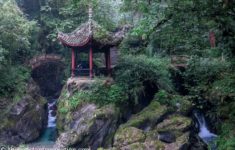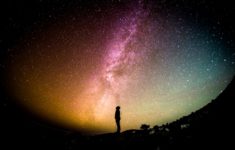The materialistic vision of the new Chinese society might have won over religion, but not over the strength of superstition, and thousands of years of cultural heritage. Taoism has remained in this form, but is the original wisdom completely lost?
One thing can be said for sure: many, many Chinese go and visit any site that is considered holy, sacred or somehow connected to Buddhism or Taoism. These places are literally invaded by tourists.
I have seen it in the city’s temples, on the two UNESCO-listed Mount Emei and Qingcheng, but also in more remote, harder places to reach like Yading, where hordes of visitors go up to 4,700 m armed with oxygen bottles to see the lakes, of course, but mostly because the Nature Reserve revolves around three Buddhist holy mountains.
However, in the few occasions I managed to speak with Chinese people and asked about where to learn Taoism (Buddhism is kind of different story because it can be learnt elsewhere too) they looked at me startled. They would suggest to me to go to this temple or this mountain, which I did with no results. But learning it, nope.
I would have loved, say, to take a class as I did for a Buddhist technique of meditation, Vipassana, in India. I couldn’t find anything of the kind. Some told me to do Taichi, which is a martial art linked to Taoism, suggesting (maybe) that through it I could develop a Taoist spirituality as well. And this is probably true. Yet, practising a martial art is a much longer and committing exercise. It’s kind of like Yoga, which can take you to a deeper meditative state, they say, but after years and years of practice. Definitely not possible in my case.
I was looking for some ways to grasp the main concepts, the meaning of being Taoist. Some explanations of the religious iconography and the meaning behind it, the beliefs, the way of life. I’ve seen the temples, the statues, even the monks practising chanting and rituals (which I did not understand), but no explanations. Why?

A first reason could be the language barrier. Perhaps it simply isn’t possible to understand and learn the ways of the Tao without speaking Chinese. Understandable, it is a very specific Chinese philosophy and I am the one at fault here. I am in China, I can’t claim people speak English to me, especially when it comes to their own culture and teachings.
Or perhaps, it isn’t foreseen by the government policies. The deliberate attempt to relegate Buddhism and Taoism in the realm of folklore, more like a show than real ways of life, is quite obvious. One thing is to go visit sacred places, pay expensive entrance fees, buy souvenirs, sleep in hotels and consume in restaurants, and let the economy roll. Another thing is to instruct people on these ways or push them on a religious path.
Sacred sites have multiplied in recent years and the government has sponsored their development, built roads and temples, even asked priest and monks to officiate the sites’ holiness through their rituals. There’s an interesting article published in the New York Times Magazine about all of this.
Probably some of this ritualism is truly felt, there is a revival of the interest on this kind of spirituality from the emerging, richer, travelling middle Chinese class, and from tourists all around the world. Yet, one should make no mistake about it, this is happening because the party has decided tourism is the Chinese way. There are lines that can’t be crossed. That interest on the other hand is more curiosity, and focuses on superstition rather than meaning, which is, say, touching a statue for good luck or fortune rather than discovering or following a meaningful way of life.

Another reason Taoism cannot be studied so easily is perhaps that it isn’t possible to learn the Tao with words, but only by practising one or more of the arts associated to it: martial arts, painting, calligraphy, poetry, meditation, medicine, cooking, fortune telling… whatever it is.
Laozi, the founder of Taoism and allegedly the author of its main text of reference, the Tao Te Ching, wrote in the opening of the book:
Tao (The Way) that can be spoken of is not the Constant Tao’
The name that can be named is not a Constant Name.
Nameless, is the origin of Heaven and Earth;
The named is the Mother of all things.
Thus, the constant void enables one to observe the true essence.
The constant being enables one to see the outward manifestations.
These two come paired from the same origin.
But when the essence is manifested, It has a different name.
This same origin is called “The Profound Mystery.”
As profound the mystery as It can be, It is the Gate to the essence of all life.
Taoism, Buddhism and the unspoken truth
Mystical, right? You can read it over and over and keep thinking about what it means. Taoists used to speak in riddles like that. To me, it means that the essence of all things cannot be explained with words, it can only be perceived with intuition, instinct, and perhaps training. It’s a feeling, a sensation that goes beyond the human capacity to show and explain, while the Tao, the Way, is just a gate that shows the road towards a deeper understanding of reality.
It reminds me of the Buddhist practice of Vipassana, which follows the teachings of the Buddha himself, and it is based on physical sensations. To reach enlightenment, to reach Nirvana (although technically it is wrong to speak about “reaching” Nirvana), one has to train really hard, with his mind and body. The Buddha used to say that he could only show the way, that he developed a method to learn how to do so, but he couldn’t explain what Nirvana is. That can only be experienced. So, the ultimate truth of Buddhism cannot be explained in words.
In the fascinating book the Tao of Physics, the author compares these ancient philosophies with modern physics and what we have discovered so far about the reality of the universe. He insists on how hard it is to explain in words a reality that has four dimensions, or the reality of quantum physics, which are both so distant from human perceptions. Perhaps, he says, it’s possible to perceive the depth of such realities through mathematic formula, in an intuitive way, for the few elected who are capable of doing so. But it isn’t possible to describe it in words.
That’s why it would be so cool to have a direct experience of Taoism. How do Taoists get to experience the essence of the Tao? How do they learn? How do they train their intuition? Do they still do it with this purpose in mind? Is there a purpose? Or has it become just a religion and a money making machine for naive tourists? I am afraid these questions will remain unanswered to me, for now.
The strength of superstition
It must be kept in mind that Taoism is an over 2,500 years old philosophy. As it happened for Buddhism (and others too) over time it underwent profound transformations. From a system of thought with the purpose of showing a way of life, it has become a fully fledged religion.
Taoism developed along with Confucianism in an era of turmoil and disorder. Both philosophies looked for social harmony and both spoke in aphorisms. Confucianism can be associated with hierarchy, order, social responsibility, conformity, moralism, activism, service and seriousness. It’s hard not to see how much that is infused in Chinese society. Taoism instead can be associated with individualism, freedom, non-conformity, nature, tranquillity, mysticism, and wit.
It’s a fun, relaxed way of looking at life. Don’t work too much, live in balance with nature, enjoy your time, accept what you are and what you have, enjoy the simple things, be in the moment. One of the main ideas was that of inaction, which doesn’t mean do nothing, but it rather means go with the flow, and do what you enjoy doing. Another major idea was that of opposites in harmony, represented by the famous symbol of Yin and Yang, the good and the bad, the male and the female. But again, these characterizations of reality by opposites would not be absolute, or still. Yin and Yang are like the sky and the earth, they coexist, one cannot be without the other, they move and transform continuously, and at all times there’s always a little of one into the other.
Confucianism and Taoism were somehow complementary for a long time. They acted together to shape Chinese society and culture, and at some point they were kind of reunited in what has been called Neo-Confucianism.
However, it’s a little harder to see the influence of Taoism nowadays. It is there, in the culture of everyday living, in the behaviour of single individuals rather than society as a whole. It’s in the good night stories, the proverbs, the cooking, the traditional medicine, the arts, and the superstitions.
Over time, a little by transformation and a little by taking from older folklore, Taoism became something of a complex religion, with priests, sacred scriptures, temples, rituals and a plethora of Gods, and immortals, heavens and mystical legends. Laozi himself, or some forms of reincarnation, has started to be worshipped as a God. Funny, as when you read the Tao Te Ching there isn’t even one mention of gods or worship.
Some of this rituals are preserved. That’s probably what I have seen performed in the temples by the priest or priestesses: some kind of chanting with high paced beat to follow; it can go on for quite some time. I also saw Taoist priest working as fortune tellers, painting, or meditating in the midst of a quiet nature on their Sichuan sacred mountain Qingcheng. Such different types of behaviours. It’s hard to separate folklore and religion, faith from superstition. In modern China they are one and the same.

Chinese might call themselves atheists in most cases, but I have seen many people saying prayers, making the statues shiny with repetitive touching, bowing three times in front of the temples, and light up joss sticks or candles. They might be unaware of it, but if they believe, say, in the necessity to worship ancestors, then they are Taoists. Just as if they believe in reincarnation they are Buddhists, or both.
The materialistic vision of the new Chinese society might have won over religion, but not over the strength of superstition, and thousands of years of cultural heritage.
You never know, right? That is more or less how the Christian atheist thinks, when he says a prayer in a moment of difficulty, or when he stops advancing on the road because a black cat has just crossed it.
It’s likely that many Chinese make confusion between Taoism and Buddhism. I have seen the Yin and Yang symbol used in Buddhist sacred places, certainly carved there by the modern man, and other similar kinds of mixed up concepts. When I asked directly, they couldn’t really explain the difference, or even tell me the details of one or the other religion. Being Taoist or Buddhist means to go to the temple from time to time, make an offer, pray for prosperity and good fortune.
When Taoists and Buddhists met
Indeed, there are many similarities among Taoism and Buddhism. When Buddhists monks arrived in China, at the beginning of the first millennium, found a fertile ground of discussion with Taoists. Both systems of thought have forms of meditation, concentration and respiration. Both have martial arts linked to it, Shaolin for Buddhists and Wudang (which includes Taichi) for Taoists. Both speak of balance with nature, of some kind of unspeakable truth, or enlightenment, of the unity of all things. It is easy to imagine how they might have talked, exchange, and influence one another.
Buddhism in China has developed different schools, which then propagated in South-East Asia and Japan. It can be very different, more ritualistic and folkloristic than other forms more focused on meditation.
By visiting the sacred places, temples or mountains, I noticed the iconography of Buddhism and Taoism are very similar here. There are many gods, many reincarnations of the main thinker (Buddha and Laozi), many wooden, stone or golden statues, sometimes with many arms protruding from the body. The differences are minimal, for example Taoist statues have a long beard and often carry a weapon, like a sword. The architecture of the temples, the food offer, the joss sticks and candles, some symbolism like the swastika, all can be found in both. The rituals of the monks are also similar and as precluded to the layman.

The two schools have so much in common that some people thought that when Laozi moved west, as the legend says, he went to India and there he became known as the Buddha. A few centuries later, his ideas came back in that new form. Obviously this is not how it went, but that’s how much the two religions, not the original system of thoughts, have in common.

Indeed, in all these places, Taoists or not, people bow, and pray, and touch the statue of the Buddha or some animals or gods for good fortune, or they through a coin in a fountain with a frog god, or they ask a priest to read their future, or they make an offer, or they follow with transportation rituals they don’t understand.
It doesn’t matter. They do not need to know the difference between Buddhism and Taoism, or the specifics of the teachings. That’s not why they are there. The superstition is stronger, even when you don’t call it a religion. That is what is needed to fulfil their needs, probably the needs of the majority of the people in the world, Chinese or not.
Are the old ways lost?
In my quest to understand what has remained of the old ways of Taoism in China, and have a direct experience of it, I have failed.
In a way it is easier to understand Buddhism as it has become a religion followed and practised in many places in the world. So it can be studied and learnt in different ways, through readings or classes, or meditation courses. This includes the understanding of the old ways.
But when it comes to Taoism it’s a whole different story. I have asked everyone I met but no one could tell me how to learn something about it, especially without speaking Chinese. All I could do was to observe the folkloristic part of it, the tourist traps, the money-making machine.
Yet, both Buddhism and Taoism are not merely religions, they are ways of life carrying great wisdom from a faraway past. They have become religions over time to fulfil the needs of many people.
Buddhism is on a rise in the world, I doubt it will be lost, but Taoism is peculiar to China. China is Taoist, among other things. It would be a shame to lose completely its teachings, or to relegate them to a limited elite of people like priests or martial artists that dedicate their life to spiritual development.
God knows (so to speak) how much need there is nowadays to get rid of the material in favour of the immaterial, and how precious those philosophies that teach a simple way of life and the balance of mankind with others and with nature are.
Suggested sources for further readings
To understand a little more about Taoism and Easter thinkers I have followed a very good audio class called Great Minds of the Eastern Intellectual Tradition, by Professor Grant Hardy. It can easily be found online.
I have also read the book “Apologia del Taoismo” by Giuseppe Tucci. Unfortunately, I am not sure an English translation exists. However, there are some other options written by English or American scholars on the market. Just try and pick something written by a serious researcher.
The book of physicists Fritjof Capra the “Tao of Physics” is an incredibly interesting reading which provides an overview of the main Eastern philosophies: Hinduism, Buddhism and Taoism. It also provides an overview of our understanding of physics with the theory of relativity and quantum physics. In the second part it gets kind of technical on quantum mechanics and it becomes a bit harder to follow, for me at least.
I have come across this beautifully written article on the New York Times Magazine “The Rise of Tao”. It’s from 2010 but in my opinion still valid in all its content.
I have consulted several online sources, websites and blogs. Nothing particular important to signal there, but it’s useful to have a general idea of how Taoism is perceived in its most folkloristic form, and how differently depending on the source. You can just Google “Taoism in China” and check some sources that pop up.








Brilliant article!
Interesting article. It does seem like we are living in a dark age or Kali Yuga, when so many ancient traditions are all but dead thanks to the West’s “Enlightenment” and monotheism. Have you read “Opening the Dragon Gate” by Chen Kaiguo or “Chronicles of Dao” by Ming-Dao Deng? They are about the experiences of Taoist seekers in modern times, somewhat fantastical like Castaneda’s books, but very interesting. I don’t have much hope for finding authentic spiritual traditions again until this Kali Yuga has played out and the whole world is at a low point of materialism, degeneration and strife (which doesn’t seem far off).
Thanks for your comment and for the suggestions, I’ll definitely look into these books!